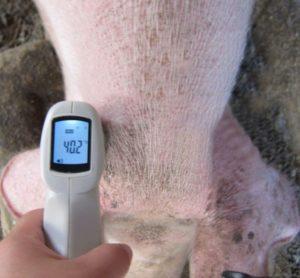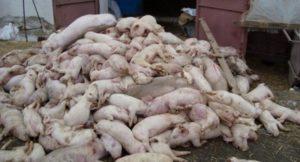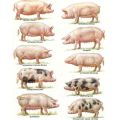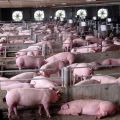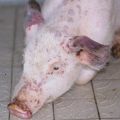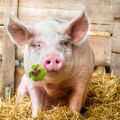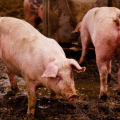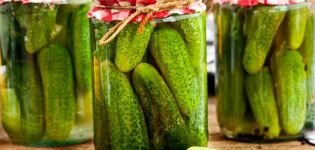Reasons why a pig does not eat after farrowing and what to do, treatment methods
Good appetite in animals indicates their health. If the pig does not eat after farrowing, many are interested in what to do in such a situation. First of all, it is recommended to determine the causes of this violation. Various diseases, helminthic invasion or violation of the rules for caring for animals can act as provoking factors. Based on the results of the examination, the veterinarian will give recommendations for treatment.
Reasons for decreased appetite after farrowing
During labor, animals lose a lot of strength and face severe stress. Normally, pigs' appetite appears 7-10 hours after farrowing. At the same time, they are given liquid food from a mixture of cereals. It is also permissible to use a milk chatter on bran.
If after 12 hours the appetite for the animal does not return, it is worth looking for the reasons for the unusual behavior. The pig may lose appetite in such cases:
- development of pathologies;
- unsuitable food - it may be too cold, hot or tasteless;
- postpartum stress - observed in pigs that give birth for the first time.
It is recommended to distinguish between a deterioration in appetite, which is considered normal for a weakened pig, and a complete refusal to eat. If the pig has a poor appetite, it should be fed soft food that contains many vitamins. Within 2 weeks after giving birth, the animal should return to normal feed intake and even exceed it.
Aversion to feed
With the wrong organization of feeding, there is a risk of indigestion. This is observed when using food that is too hot or cold. Also, the provoking factor of problems can be the use of unmilled food. Similar violations occur with a sharp change in diet. The intestines of piglets are especially sensitive.

Diet disorders often provoke poisoning and the appearance of diarrhea and constipation. There is also a risk of gastroenteritis. Any disturbance in the digestive functions causes a deterioration in appetite. It should be borne in mind that pigs do not always refuse to eat when diseases develop. Sometimes they just don't like the food the farmer gives. In such a situation, it is worth introducing more varied foods into the diet.
Avitaminosis
After farrowing, the animal may lose its appetite due to vitamin deficiency. This condition is accompanied by a change in skin tone in piglets. They don't get enough elements from milk. As a result, there is a risk of skin blanching or peeling. In the pig itself, a deficiency of vitamins A and D provokes weakness of muscle tissues and joints. She is unable to stand up or has difficulty getting up.However, gait can be shaky and unsure. To avoid such problems after farrowing, the animal is advised to inject vitamins or add premixes for lactating females to food.

Improper maintenance and care
Pigs can lose their appetite due to improper housing conditions. To avoid such problems, it is recommended to monitor the room temperature. Significant deviations can cause negative consequences. To avoid this, it is recommended to monitor the following parameters:
- lack of drafts in the pigsty;
- suitable temperature parameters;
- optimal humidity;
- air purity.
A significant disturbance in the temperature in the room makes the pigs lethargic and provokes a deterioration in appetite. Allowable humidity parameters are at the level of 50-70%. It is also recommended to monitor gas levels. With their increase, the condition of the animals worsens.

Stress
This animal can hardly endure stress and easily succumbs to it. The pig's body is characterized by high excitability. When relocating, it is difficult for an animal to adapt to new conditions. The causes of stress include the following:
- changing the temperature regime in the room;
- excess of animals in the pen;
- changing the usual diet;
- poor-quality air in the pigsty - the cause of problems is the accumulation of hydrogen sulfide or ammonia in the room.
To prevent the occurrence of problems, experts advise avoiding the effects of stress on animals. In an unfavorable combination of circumstances, there is a risk of death of the pig. With regard to the diet, it is not recommended to introduce feed abruptly. Pig nutrition should be changed gradually. In order to facilitate adaptation and avoid stress, it is recommended to add play materials such as bedding or rope to the pen.
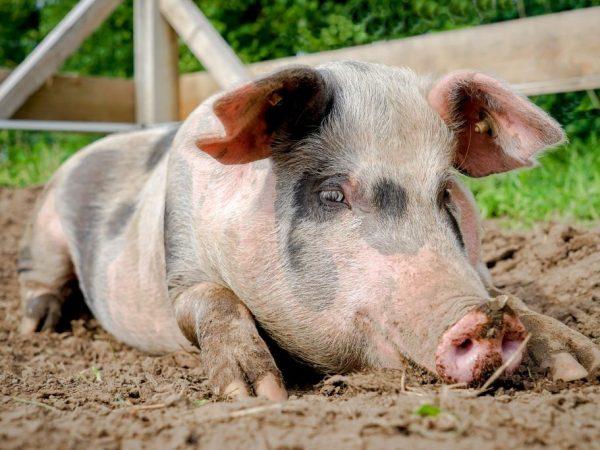
Disease
The development of pathologies is considered the most common cause of loss of appetite. Most diseases lead to poor appetite. The most common diseases include the following:
- infections - primarily of a viral nature;
- helminthic invasion;
- traumatic injury;
- lesions of the respiratory system;
- poisoning with poor quality food.
It should be borne in mind that there are specific symptoms that determine the disease. At the same time, only the help of a veterinarian will help to eliminate the pathology. To begin with, it is recommended to isolate the sick pig from the rest.
Treatment methods
To cure the sow, it is important for her to make an accurate diagnosis. Infectious diseases are recommended to be treated with antibacterial drugs. For this, Tylosin, Bitsillin, Amoxicllin are used.

After a course of antibiotic therapy, probiotics should be used. They are required to normalize microflora. With a small cold, it is permissible to use folk recipes - decoctions of nettle, linden or chamomile.
How to make feed attractive to pigs?
Sometimes pigs lose their appetite after farrowing due to poor nutrition. This problem is common, but it can be solved. These animals love sweet, salty, sour and bitter foods. To make the feed more attractive to pigs, it is recommended to add salt, sugar, mustard to it. Lactic acid is also acceptable. In this case, the supplements should be alternated.
Many farmers prefer to add essential oils to their feed. These substances are attractive to many pigs. To increase the piglets' appetite from birth, after farrowing the pig, it is worth using food with essential oils. This will give the milk a pleasant aroma and increase the baby's appetite. Other foods that pigs love include:
- boiled or steamed cereals;
- roasted grains;
- baker's yeast.
The yeast method is considered to be very effective. It is permissible to use it even if the animal does not eat and does not rise. After the introduction of such a diet, the condition of the animals improves. This result is achieved due to the presence of a sufficient amount of proteins, vitamins and amino acids in the feed.
Poor pig appetite after farrowing can be attributed to a number of factors. It is worth consulting a veterinarian to determine the reasons. In case of detection of dangerous diseases, it is recommended to choose an effective therapy. In other situations, additional components will help to increase the attractiveness of the feed. Correction of care and minimization of the influence of stressful situations are of no small importance.
